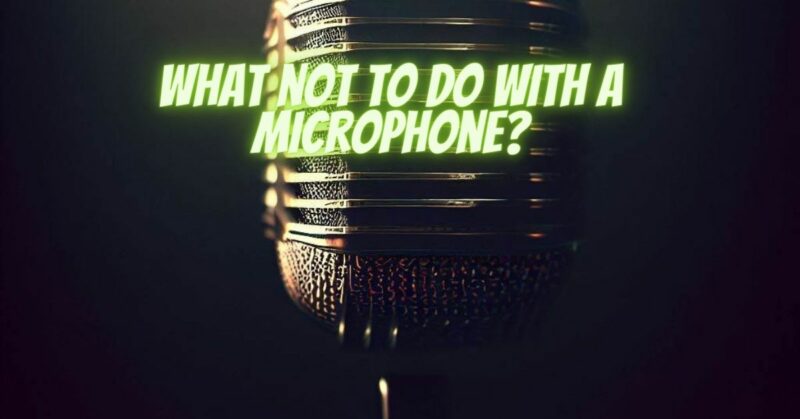Microphones are essential tools for capturing clear and high-quality audio in various settings, including performances, public speaking events, and recordings. To ensure the best sound reproduction and protect the longevity of microphones, it is important to follow proper microphone etiquette. In this article, we will discuss what not to do with a microphone to avoid common pitfalls and potential issues.
- Avoid Dropping or Mishandling the Microphone:
One of the most important rules is to handle the microphone with care. Dropping or mishandling a microphone can cause internal damage, affect sound quality, and potentially render the microphone unusable. Always hold the microphone securely, avoiding excessive force or rough handling that may lead to component misalignment or physical damage.
- Refrain from Blowing, Tapping, or Hitting the Microphone:
Blowing into the microphone, tapping it, or hitting it with your hand or any object can cause significant damage. These actions can harm the sensitive diaphragm, disrupt the internal components, or result in distorted or muffled sound. Treat the microphone as a precision instrument and avoid any actions that could compromise its functionality and performance.
- Minimize Contact with the Microphone Grill:
The microphone grill protects the delicate internal components and helps reduce unwanted noise. Avoid touching or rubbing the microphone grill with your fingers, hands, or any objects. Unintentional contact can create handling noise, transmit vibrations, or transfer oils and dirt onto the grill, affecting sound quality and potentially causing long-term damage.
- Don’t Spit or Expose the Microphone to Excessive Moisture:
Spitting into the microphone or exposing it to excessive moisture, such as blowing saliva or liquids onto it, can lead to corrosion, damage the diaphragm, or cause electrical short circuits. Always keep the microphone dry and avoid using it in environments with high humidity or proximity to liquids.
- Refrain from Cupping or Blocking the Microphone:
Cupping or covering the microphone with your hands or any objects can alter the sound characteristics and degrade the audio quality. This action creates acoustic reflections and can introduce unwanted bass buildup or muffled sound. Maintain an appropriate distance between your hands or objects and the microphone to allow for proper sound capture.
- Avoid Exposing the Microphone to Extreme Temperatures:
Extreme temperatures can affect the microphone’s performance and potentially damage its internal components. Avoid leaving the microphone in direct sunlight, near heat sources, or in extremely cold environments for extended periods. Allow the microphone to acclimate to room temperature before use to ensure optimal performance.
- Don’t Use Excessive Force When Connecting Cables:
When connecting or disconnecting cables from the microphone, avoid using excessive force. Pulling on the cable instead of the connector can strain the cable’s internal wires or damage the connector’s pins. Handle the connectors with care and ensure a secure but gentle connection to prevent any potential damage.
Conclusion:
Proper microphone etiquette is essential for maintaining the integrity and performance of microphones. Avoid dropping or mishandling the microphone, refrain from blowing, tapping, or hitting it, minimize contact with the microphone grill, and avoid exposure to excessive moisture or extreme temperatures. Additionally, refrain from cupping or blocking the microphone and handle cable connections with care. By following these guidelines, you can ensure the longevity of your microphone, preserve sound quality, and create a professional and enjoyable audio experience for both yourself and your audience.

